Long load times.
Graphics intensive page due to loading of photos and slide shows. Please be patient...
8th ATTACK SQUADRON ASSOCIATIONKUNSAN AIRBASE 8th BOMB SQUADRON (L-NI)
(1951-1954)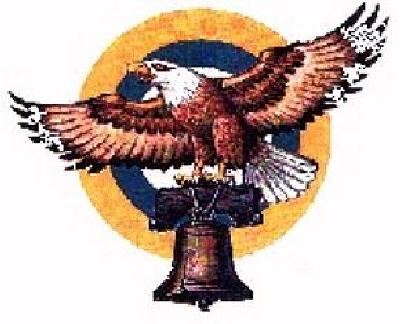 Page 2 of 4 |
 - Squadron Insignia
- World War I and between the Wars (1917-1941)
- World War II (1941-1945)
- Occupation Forces in Japan -- Convert to B-26
- Korean War
- After the Korean War -- Johnson AB (1954-1960) and Yokota AB (1960-1964). Convert to B-57Bs (1957) with nuclear alerts at Kunsan AB (1958-1964)
- Vietnam -- 3rd Bomb Wing (Tactical) goes to Florida to convert to F-100s. Last B-57 squadrons in USAF get a reprieve from deactivation. B-57s to Vietnam: 8th & 13th attached to 41st AD and 2nd AD. (1964-1969).
 8th Bombardment Squadron (L-NI)
Kunsan Air Base (K-8)
(1951-1954) |
 8th Bombardment Squadron (L-NI):Acknowledgment: Special thanks to Hans Petermann of San Diego, California for his technical notes on the B-26, photos and narratives that are used throughout the site. Also thanks to Jack Boyer of Santa Clarita, California for his photos and narratives to this section. Also thanks to Dave Bradburn for his narratives. We are extremely grateful to Al Gould for his narratives, commentary and photos. Thanks to Harold Locke for his photos. Thanks to Larry Casseria for his narratives and photos. Thanks to Paul T. Ono for his narratives. Thanks to Craig Hinton for his photos of the post-Korean years in Korea. In addition, we wish to express our gratitude to the late Jack Barclay of Bohemia, New York for his photos, maps and other invaluable reference materials. (Godspeed, Jack!) Thanks to the marvelous historical site of the 3rd Wing History Office of Elmendorf AFB, AK for its historical materials. We are deeply indebted to the Joe Baugher website for its wealth of historical information on aircraft.  8th Bomb Squadron insignia 8th Bomb Squadron insignia
Approved June 21, 1954

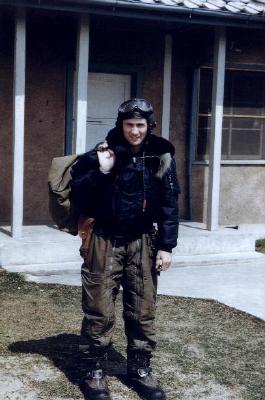
Hans Petermann in combat gear (April 1952) Click on photo to enlarge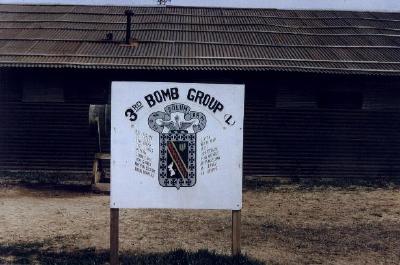
3rd Bomb Group Headquarters (April 1952) | 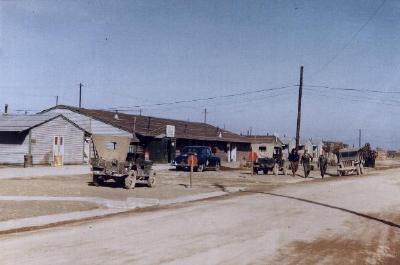
3rd Bomb Group Operations (April 1952) | 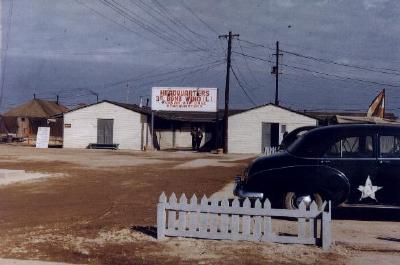
3rd Bomb Wing Headquarters (April 1952) | 
8th Squadron Ops (April 1952) | 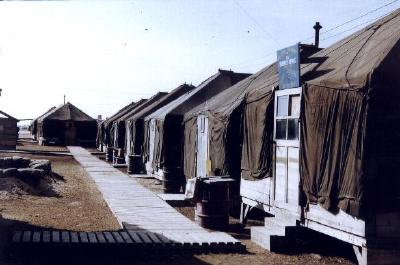
8th Squadron Area (1952) | 
EM Barracks (1952) | 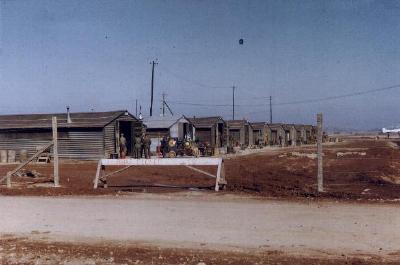
3rd Maintenance Group (April 1952) | 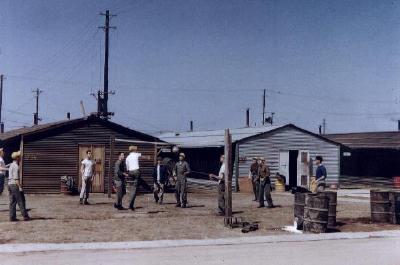
Recreation (1952) | 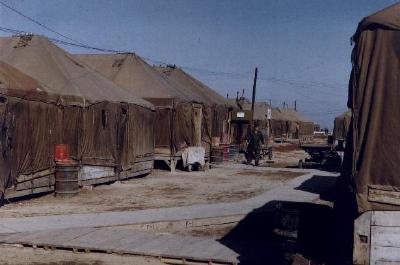
Storage Tents (1952) | 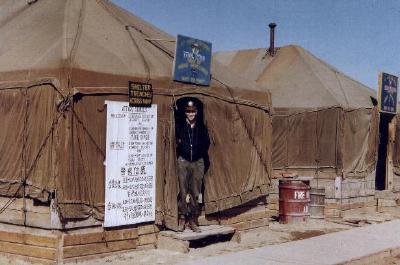
Tool Crib (Hans Petermann - OIC) (1952) | 
MSgt Davidson and friends (1952) | 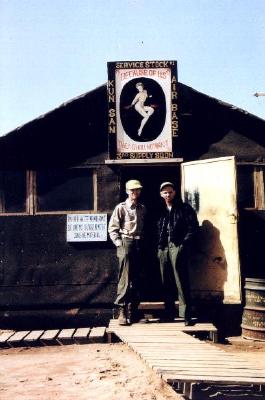
Hans Petermann & Al Connor (1952) | 
Flightline (1952) | 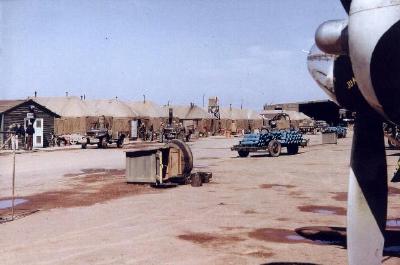
Flightline (1952) | 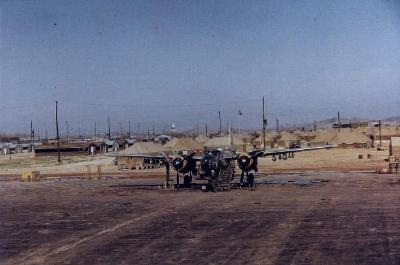
Flightline (1952) | 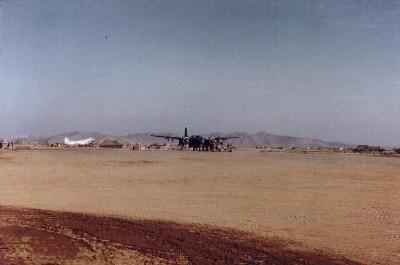
Flightline looking East (April 1952) | 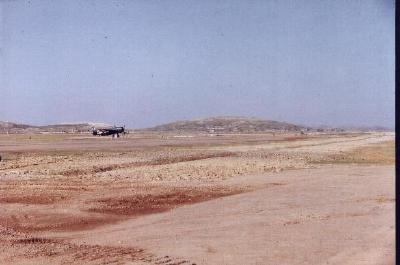
Flightline looking Northeast (1952) | 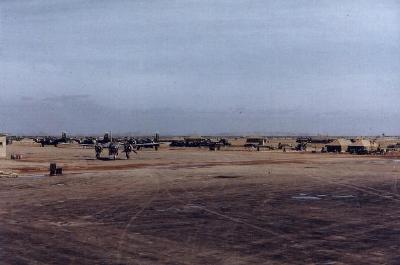
Flightline looking South (April 1952) | 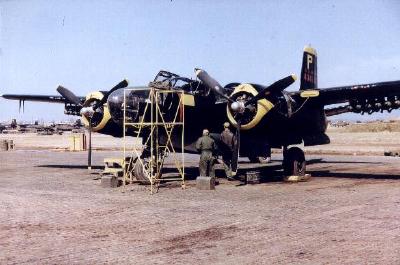
B-26 #618 (1952) | 
B-26 #312 Texas Special (April 1952) | 
B-26 #312 Texas Special (April 1952) | 
B-26 Midnight Rendevous (1952) | 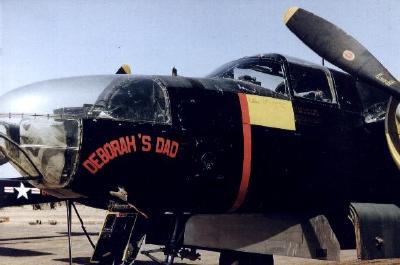
B-26 #700 Deborah's Dad Capt Cecil Poss (plt)/Capt Baer (Shoran) (1952) | 
Big Boys on the flightline (1952) | 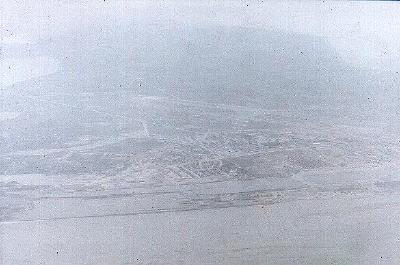
Aerial view of Kunsan Air Base (1952) | 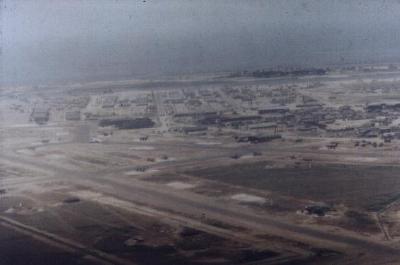
Aerial view of Runway (1952) | 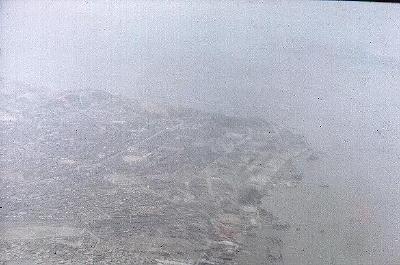
Aerial view of Kunsan City (1952) | 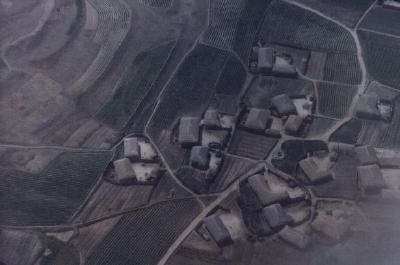
Aerial view of Village Near Kunsan (1952) | 
Runway landing (1952) | 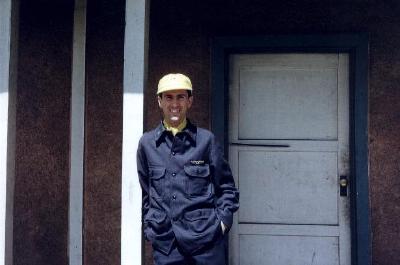
Hans Petermann (April 1952) |
Hans Petermann of San Diego, California photos of life at K-8 in 1952.
The Way We Did BusinessThe following is an excerpt from an email from Hans Petermann of San Diego, California about how the 8th went about its business: "We didn't have crew integrity. As a navigator, bombardier and radar operator I trained with a pilot and gunner as a crew at Langley AFB, went over as a crew, was assigned to the 8th as a crew. There it ended. I flew with my pilot three times, one of them being our last mission. ( And I found out he had become a "Tiger"). In between I flew with 42 different pilots in 55 missions, some from Group and Wing. As a result, there was a wide spectrum of my experiences with these pilots - from strafing at 9500 ft (!?!) to my refusal to refly with a new pilot because of his disregard of my warnings about terrain elevation in the mountains during his attacks. (This was on his 3d mission (my 42nd) and he didn't return from his 5th)."
But it wasn't only the fool-hardy that didn't return from their missions...a lot of brave men didn't come back. The following is a message by Sandra (Fluke) Knutson in the Korean War Project where she talks about her father, a member of the 8th Bomb Squadron and his last flight. 1 Jul 1998 "Sandra (Fluke) Knutson" ... Gresham, OR
datein: May 1947 dateout: July 2, 1950
comments: 8th Bomb Squadron, 3rd Bomber Wing - July 2, 1950- took off with formation to hit target in Seoul area. Adverse weather conditions, forced to approach low up Han River, intense groundfire, evasive action shook bomb loose, couldn't drop, Staff Sargeant Robert W. Fluke secured bomb, losing fuel ditched B-26 in East China Sea, pilot Lt. Jack B. Eno knocked out,underwater explosion, intensive search, no result. Lt. Eno picked up by fishermen and survived to tell the story of my father's last mission. |
A lot of men went off to war and didn't come home...leaving behind family and children too young to remember them fully. The pain never left as children seek information of the fathers they never knew. One such person is Susan Bradley seeking information on her father 1LT Ralph Bradley in the Korean War Project in September 1998. She wrote: I am seeking any further information on my father - 1LT Ralph Porter
Bradley, listed as died while missing 12-31-1953. Where was he
captured, what camps, how do we know he died, when were the US
authorities notified and by whom?
1LT Ralph Porter Bradley was with the 8th Bomb Sq, 3rd Bomb Group (L)
as a navigator from 22 April 1951 thru 16 June 1951. On June 13, 1951
he was declared missing in action and dropped from rolls 16Jun51.
It shows 22 combat missions, missing on the 22nd.
I was only 2 1/2 years old when we lost him. I really would like to
know if anyone remembers him or his crew members. Any information would
help me put together his family history as well as mine.
Thank you for your assistance.
Susan R. Bradley
Rt 2 Box 143-D
Brundidge, Alabama 36010
334-735-5776
E-MAIL: sbrad@snowhill.com
|

1st Lt Ralph Porter Bradley
(Click on image to enlarge)There is a happy ending to this story. Susan Bradley wrote in December 1999 that she had found her lost relatives through this KWP letter. From them she received a package that contained her father's "wings" and his engraved Purple Heart award...50 years later. She wrote, "...wow where to begin. About three weeks ago I got an email message entitled 1LT RPB..while I was at work, so I didn't look at it right away. (Dumb) Anyway, it turns out it was from my cousin who is the son of my Dad's brother (Fred). It turns out they have been looking for me forever. He found my message on the KWP message board and thought this has got to be her. SO....to make it short, I now, much to my delight, have found an Uncle and cousins, Surprise 2 sisters (Aunts) I NEVER even knew about and a bunch more cousins. WHEW!!! Have been emailing like crazy, letters and the same day I got the email from Leslie, surprise he called that same evening from...are you ready! The Phillipines. He was so excited to find me, he had also called his Dad in Florida (3 hours from me) at 3 AM in the morning CST. SO, I have already received a package from Leslie, last weekend containing some baby things of my Dad's. AND today, boy shivers and goosebumps abound....another package containing some patches, wings and WOW, my father's engraved Purple Heart award." A highly-emotional end to a search that would melt any heart.
Medal of Honor: Capt. John S. Walmsley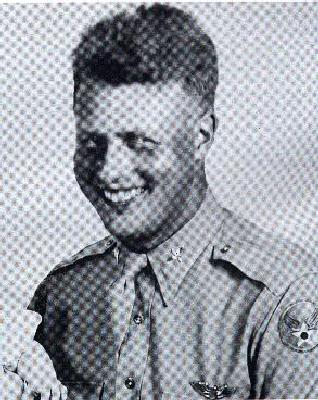 Capt. John S. Walmsley Capt. John S. Walmsley
(Click on photo to enlarge)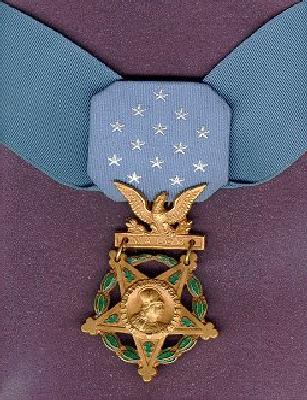 Army Medal of Honor Army Medal of Honor
The Army Medal of Honor was awarded to Captain Walmsley.
The Air Force did not have its own Medal of Honor until 1965.
(Click on photo to enlarge)
Another man who didn't come back was John Walmsley, a pilot in the 8th Bomb Squadron. The Korean Air War by Robert Dorr and Warren Thompson (pp87-88), has a story about Capt. Walmsley and his searchlight equipped aircraft. "On the night of 12 September 1951, near the North Korean urban center of Hwangju, Capt John S. Walmsley of the 8th BS made use of a searchlight designed for night-intruder missions in the B-26 Invader, but regarded with mixed feelings by those who used it. Attacking enemy convoys and troop movements at night was a tough proposition, and not all B-26 pilots were convinced that a searchlight offered any improvement over flares. An 80-million-candlepower searchlight the size of an external fuel tank (used, once, on Navy blimps to stalk Nazi submarines in WWII) offered excellent illumination over target, but was cumbersome and induced considerable drag, reducing the B-26's speed and range. Some lights caught fire and had to be jettisoned, while others snapped off the brackets that held them."
"Captain Walmsley and his B-26 crew located a Chinese convoy and halted it with a load of 500lb (227kg) bombs. Walmsley then turned on the searchlight and used it to light up the enemy troops in stark relief while he flew the B-26 Invader repeatedly over the stalled convoy. Using fragmentation bombs and gunfire, Walmsley destroyed at least 16 trucks. In the nose of the B-26, bombardier Lt. William D. Mulkins reported that Chinese trucks drivers were terrified by the blazing searchlight and drove their vehicles into trees, off the road, and into one another."
Two nights later on September 14, 1951, John Walmsley using a searchlight-equipped B-26 for his intruder missions, encountered a train and managed to halt and disable it. However, he ran out of ordnance before it could be completely destroyed. He called in another 3d Bomb Wing Invader and made illumination passes taking heavy anti-aircraft hits on each pass. On his third pass, the wings exploded in flames. He was killed on impact and awarded the Medal of Honor for his actions. On June 12, 1954, at Bolling AFB, D.C., Secretary of the Air Force Harold E. Talbott presented the Medal of Honor to Walmsley's widow. His citation reads: WALMSLEY, JOHN S., JR.
Rank and organization: Captain, U.S. Air Force, 8th Bombardment Squadron, 3d Bomb Group. Place and date: Near Yangdok, Korea, 14 September 1951. Entered service at: Baltimore, Md. Born. 7 January 1920, Baltimore, Md. Citation: Capt. Walmsley, distinguished himself by conspicuous gallantry and intrepidity at the risk of his life above and beyond the call of duty. While flying a B-26 aircraft on a night combat mission with the objective of developing new tactics, Capt. Walmsley sighted an enemy supply train which had been assigned top priority as a target of opportunity. He immediately attacked, producing a strike which disabled the train, and, when his ammunition was expended, radioed for friendly aircraft in the area to complete destruction of the target. Employing the searchlight mounted on his aircraft, he guided another B-26 aircraft to the target area, meanwhile constantly exposing himself to enemy fire. Directing an incoming B-26 pilot, he twice boldly aligned himself with the target, his searchlight illuminating the area, in a determined effort to give the attacking aircraft full visibility. As the friendly aircraft prepared for the attack, Capt. Walmsley descended into the valley in a low level run over the target with searchlight blazing, selflessly exposing himself to vicious enemy antiaircraft fire. In his determination to inflict maximum damage on the enemy, he refused to employ evasive tactics and valiantly pressed forward straight through an intense barrage, thus insuring complete destruction of the enemy's vitally needed war cargo. While he courageously pressed his attack Capt. Walmsley's plane was hit and crashed into the surrounding mountains, exploding upon impact. His heroic initiative and daring aggressiveness in completing this important mission in the face of overwhelming opposition and at the risk of his life, reflects the highest credit upon himself and the U.S. Air Force. In The Korean Air War (p88), it states "Researcher Bill Bennett has found that four men were aboard Walmsley's B-26 Invader, rather than the traditional crew of three. Navigator/bombadier 2nd Lt. William D. Mulkins and photographer Capt. Philip W. Browning were killed with the pilot; gunner M.Sgt. George Moror escaped from the aircraft, became a POW, and survived the war. ... Soon after, FEAF abandoned use of the B-25 searchlight, which it deemed too fragile for the stress of combat." MSgt Moror's captivity is also a story of heroism. Badly burned and without medical treatment, the wounds began fester. The maggots began to eat away the dead flesh and his hands were so badly burned he could do nothing. However, he credits the maggots with saving his life. Though disfigured from his ordeal, he survived to tell his tale. 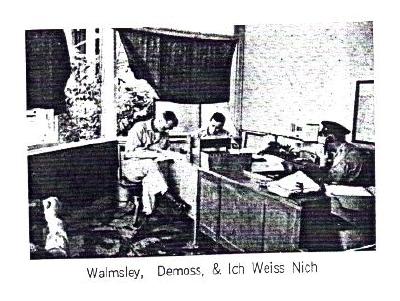  Right: Walmsley, Demoss, and Ich Weiss Nich Right: Walmsley, Demoss, and Ich Weiss Nich
Left: Only Tigers Fly This One: Searchlight on B-26
Click on photo to enlargeHarry Scarborough wrote to add some background to the Capt Walmsley story. He said, "I was rooming with Jack Walmsley in June or July of 1951. Our Eighth Bomb Squadron Commander was Lt. Colonel Edward L.Wilson, Jr. I was nearing the end of my 60 combat missions as a navigator in the 8th's B-26's. Wilson called me in to his office along with Jack and set us up to fly a practice mission using the searchlight mounted in a pod under the right wing. We took off from Iwakuni and flew for about 2 hours making practice dives on ground targets including our infamous rock off the runway that we used to use for bombing and strafing mission practice. As I recall the light, it was beaucoup candlelight and turned darkness into daylight. We probably scared the hell out of the Japanese folks living in the Iwakuni-Hiroshima area and the Jap fisherman out and about that nite. When we got back Wilson interviewed us. I don't recall Jack's comments but I did tell Wilson that any 26 using such a light over enemy lines was going to get first class attention from enemy ground troops and probably get his ass shot off. I came back to the States in August 1951, after my 60th mission which was a crash landing at K13 (Suwon), with Ed Wilson fighting the aircraft home after being badly hit while making strafing passes in the Wonsan Bay area. Two years later I was recalled home from Germany to attend the Medal of Honor presentation for John Walmsley in Washington ,D.C. My personal feeling about Jack and the use of that light was he was put in great jeopardy the minute he let down on a pass and turned that stupid light on." From 13th Bomb Squadron Website.
For more information on these searchlights
go to Those Crazy Searchlights.Another aviator who knew Capt Walmsley was Al Gould. He said, "I walked into the 8th ops room a few minutes after arriving at my new assignment in June, '51 at Iwakuni. I was with the 8th when we moved to K-8 (old Kunsan by the sea). I finished my 55 missions as pilot in Jan '51, and have some nice tales, some funny, and some not so funny during my time with the 8th. I recognize several names in your site, and was a good friend of John Walmsley. In fact he and I had the good luck (?) to have our assigned planes to fly with the "Big Spotlight." John and I shared one of the houses described in your site with about 10 others. I remember the night John didn't make it back. The light on the other bird was accidentally jettisoned, and a few days later I was told that the "light project" had been discontinued. I wasn't too sorry ---- it really makes a nice target to turn on a nice, bright "star" over enemy guns."
To recognize Capt Walmsley at Kunsan, the 8th Attack Squadron Association presented a plaque in his memory to the Loring Club on 26 June 2000. Col Moon-hyun Baek, 38th Fighter Group Commander (ROKAF), presented the plaque on behalf of the Association to Col. Philip Breedlove, 8th Fighter Wing Commander.  Col Moon-hyn Baek, Commander 38TFG, presents a plaque Col Moon-hyn Baek, Commander 38TFG, presents a plaque
honoring Capt John S. Walmsley
to Col Philip Breedlove, Commander 8FW, 26 June 2000.
(Click on photo to enlarge)(NOTE:Though the 8th FW honors Major Loring of Suwon AB by naming the collocated NCO/Officers Club at Kunsan in his honor, unfortunately the 8th FW has failed to specifically acknowledge Capt Walmsley as the Kunsan AB Medal of Honor recipient. His only official recognition at Kunsan is that he is on a large plaque with all the other Medal of Honor recipients dating back to the Civil War. We believe that this is not a sign of disrespect. It is simply that the 8th's historical agenda deals with the 8th's history...NOT with Kunsan AB's history. All previous units of Kunsan are irrelevant to the 8th Fighter Wing.)
The Early Days of the 8th Bomb Squadron at Kunsan 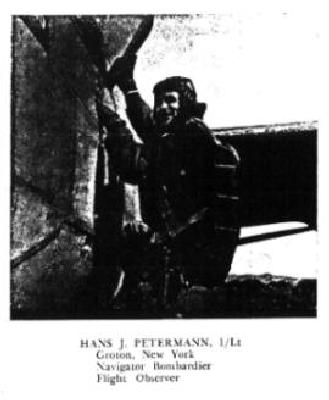 1951-1952 Jack Boyer and Hans Petermann 1951-1952 Jack Boyer and Hans Petermann
Click on photo to enlargeAs the peace talks at Kaesong that began in July 1951 dragged on through August, the 3rd Bomb Wing moved to Korea to be nearer its targets. On 18 August 1951, the Squadron moved to Kunsan, Korea under the command of Lt. Col. Stanley V. Rush. The 808th Engineering Aviation Battalion (US Army) had built a 5,000 foot runway for the light bombers, but the conditions at the base were still relatively primitive. Many of the creature comforts such as latrines and showers were still under construction. Troops were shuttled in from Japan via C-47 mail plane. Some of the parking areas and taxiways were still being covered with PSP even as the 8th started its missions. The 90th BS temporarily used the old Japanese sod airstrip as a parking ramp until the PSP was finished being laid. From Aug 51-Nov 51, the unit operated out of this area. Everywhere there was nothing but mud. 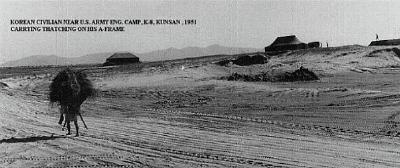 Korean Laborer at K-8 near the 808th Engineering Aviation Battalion (SCARWAF) (1951) Korean Laborer at K-8 near the 808th Engineering Aviation Battalion (SCARWAF) (1951)
(Courtesy Al Gould)Jack Boyer of Santa Clarita, California remembers his trip to K-8 (Kunsan Air Base) from Japan and his first impressions of Korea. He wrote, "I arrived at K-8 on Oct 4, 1951 as we flew from Ashia (sp) in Japan. We were in a C-47 and it was like a local bus that stopped at every small town. We were the first replacements to the 3rd BG and of course new to this thing called war. The Gooney Bird carried replacements, mail and other cargo. One of the stops was at Kimpo Air Base and there were F-86 fighters on the flightline. After our plane stopped, sirens went off and the lights in the plane went out. The pilot said it was an air raid and to get out of the plane. Of course we were scared to death, being our first nite in Korea) It was only "Bed Check Charlie" in an open cockpit bi-plane. He would fly over and drop hand grenades, hoping to hit a fighter or two. He flew over us but didn't drop anything. I think he was over Inchon harbor when we heard AA firing at him."
"Needless to say when we arrived at Kunsan as the first replacements, were treated like long lost brothers. I was 19 yrs old and an Airman 3rd Class (pfc) We had been trained at Lowery AFB in Denver, Colorado at weapons school. We were assigned to the 8th Bomb Sqdn. on the flightline as armorers. No one at school showed us how to load or arm bombs. We had just been trained on weapons maintenance and repair. The 3rd Bomb Grp had only been at Kunsan for 2 months when I got there. It was very spartan until the base could be built up." The photos above are from Jack Boyer's one and only trip downtown in 1951.
There were still guerillas operating in the area and the group had to be
accompanied by ROK guards. The trip was to the Orphanage.
 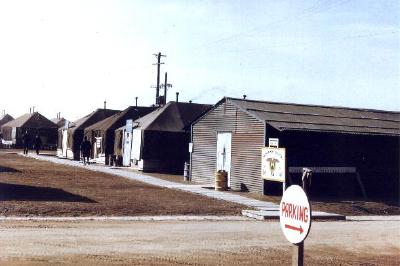 The Orderly Room and Squadron Area (Spring 1952) The Orderly Room and Squadron Area (Spring 1952)
(Note the 13th BS "Oscar" Flag flying in background on left photo)
(Courtesy Hans Petermann)
Click on photos to enlarge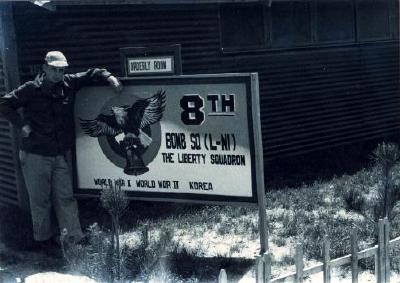 Jack Barclay at Orderly Room with the "new" insignia (1953) Jack Barclay at Orderly Room with the "new" insignia (1953)
(Courtesy Jack Barclay)
Click on photos to enlarge
Base Scenes: 3rd Bomb Group Briefing Room; Famous 3rd Supply sign; Air Terminal;
Invader Theater; Mobile Snack Bar; Personnel Services Offices; Office in winter; Squadron area
(Courtesy Harold Locke) (Click on thumbnails to enlarge)
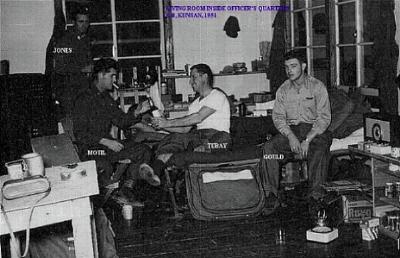 Officer Billets (1951) Officer Billets (1951)
(Courtesy Al Gould)
Click on photo to enlarge
Enlisted Barracks: Harold Locke's bunk; Frank Bowdien; Barracks Houseboy; Bomb Shelter
(Courtesy Harold Locke) (Click on thumbnail to enlarge)
 Hans Petermann in front of his billet (1952) Hans Petermann in front of his billet (1952)
(Courtesy Hans Petermann)
Click on photo to enlargeHans Petermann remembered the BOQs in those early days. He wrote in an email, "Very interesting to learn that our BOQs were built by U.S. occupation forces. As you intimated, that was never clear to us - the impression being that they remained from the Japanese. They were, though, about the only buildings left from the occupation. In one of my first letters home (20 Sep 51- my mother kept all letters I sent home, so I have reference) I commented that we were living ten to a 3-bedroom, 1-living room house. No heat, no hot water. (I always maintained that I put on more clothes to go to bed than I wore during the day). We had electricity, but since it was connected to Kunsan, it was not always reliable and we had already spent two evenings using candles. The water was on twice daily for a two-hour period, not to conserve it, but the pumping and piping facilities were at a minimum. And all through winter had to fight frozen pipes. Finally got some warm water at the end of October, but no heat until late November and then only minimal. They didn't call it Frozen Chosen for nothing. Finally in the spring, the Army Engineers built a shower facility building near our BOQs and we could then maintain some semblance of cleanliness. Some of us had begun to compete with kimchee odor." The photos by Hans Petermann covering the 1951-1952 time frame.Voron N. Baughan wrote, "I flew my first combat mission as engineer/;gunner the third night after I was all signed and bedded into the 8th Sq, 3rd BGG (L) in Dec 1950. It was 38 degrees F below at 8000' over the target in North Korea (Frozen Chosin) and with a couple guys (pilot and nav) that I had only met in the briefing room that afternoon and an airplane that I had never flown in. I had been engineer on C-47 at K-14 (Kimpo) to support the 51st Firghter Interceptor Wing up from Okinawa. I had all ready frozen both hands repairing a downed P-51 at K-14 and was still healing them."
He went on, "I don't remember anyone in the 51st or the 8th saying anything about how many missions or months that we would or could count on. I already had a year into my 2-year assignment. I had been hoping on Okinawa that I would be going to Shanghi, China on some of my C-47 flights and get some souveneirs to send home as some Bingo prizes at the NCO Club had been bought in Shanghi. How, here I was flying in a B-26 over K-14 as it was "burning up" (part of the "strategic withdrawal" from the Chinese. I was no longer interested in going to China to get presents but just to give them some "hot" 50 cal, mapalm & bombs."
He continued, "Who said anything about how many missions, etc. -- This had turned into a "war." However, this was being considered & it needed to happen. I had heard 25, 50, but as it turned out for some -- 50 missions was it, but NOT under it. There was no guarantee for anyone. (See page 13 of the 1950-1951 Yearbook. A picture of some of the 60 mission Club -- they were there from the start.) I did finally hear (about springtime) taht 75 missions was all that was allowed. So I volunteered for them. At 51 missions I was removed from Combat Crew for 30 days to fly test hops, locals, etc. for a week or so. Them me & several others rotated to the U.S.A. Yeah, we had not recieved a payday for quite a spell & was shipped out that way to the "RepelDeple" (Replacement Depo) in Japan. One of the guys saw one of our ex-navigators that we knew that was assigned to Finance there and he got us all a partial pay, "Bless his heart." Reminded me of WWII when a bunch of us B-24 engineer/gunners were declared essential (low points) so we couldn't go home with some of our own crew members. We had to crew & fly transport a/c & moved around. We didn't get paid for 5 months. At least we had rations & some food & a blanket. War has many "hells" besides other things.
He added, "P.S. I did fly as searchlight operator & engineer for 1 combat mission (one of, if not the first searchlight mission in the Sq.) with Capt. Walmsley -- the only pilot of the Korean War (in the 3rd BW) of the Korean War to be awarded the Congressional Medal of Honor. It was an honor to fly with him. He was OIC of the searchlight project."
Pat M. Smith of Milw, Oregon wrote, "I've got a day-to-day diary of everything I did in Korea 'cuz my ground job was operations when not flying. I gave Red Mosely (?) (the first quad Korea amputee) his cherry ride, almost grounded myself just before Major Kuch died, etc." He went on to talk about mission requirements to go home in 1952-1953. He said, "Everybody that flew combat '52 thru to early 1953 had to fly 55 combat missions to get the combat crew "dealie bob" and able to "fly" home when FIGMO." He added, "Another thing -- I flew with Billie Johnson a bunch & we swooped to Miho & then down to Indochina with a B-26 the USA gave to the Frenchmen before or right after Dien Bien Phu? Helluva trip & we came back with a load of good booze, etc."
Paul T. Ono of Gardena, California has a lasting impression of Kunsan from February 1952. He wrote, "I was sent to K-8, Kunsan AB, APO 970 by personnel from the 2349th Personnel Processing Group at Camp Stoneman in Pittsburgh, CA. They told me that my specialty of AFSC 32330F as a Turret System Mechanic was more critical in Korea rather than my orders which read, direct assignment to the 6004th Air Intel Service Sqdn (AISS) in Tokyo, Japan. After arriving in Yokohama, Japan on the troopship USS Billy Mitchell, we were put on a train sent to Iwakuni AB. From Iwakuni we were pipelined directly to K-8 on a C-46 Commando, and I was assigned initially to the 8th Bomb Sq (L-NI), 3rd Bomb Wg (L) as a B-26 Armorer, though I was trained as an Turret System Mechanic."
He continued, "After getting over my initial shock of being sent to Kunsan AB, I was greeted
at K-8 by a beautifully painted overhead pictorial sign with palm trees and the coastline and the words "WELCOME TO KUNSAN BY THE SEA". There was also a second sign as you entered the flight line area which read in effect, (I don't remember the exact wording but it read like), "THROUGH PORTALS PASS THE FINEST FIGHTING CREWS IN THE AIR FORCE"." He later wrote, "I recall that the location of the sign was between the 8th Bomb Sqdn and the 13th Bomb Sqdn as you approached flight line front the maintenance shacks. The sign was a large sign overhead and post mounted and there was no building near it. I remember that after I arrived at Kunsan and was in-processed, then someone from the orderly room took me by the flight line where I first noticed the sign." He continued, "These signs were posted in the right location at the right time, because they really boosted my morale. i.e. it made a very good impression on me of Kunsan AB, since at the time, I thought I was in a real bad situation."
He later wrote about the primitive dental services. "I also remember that few of the troops, including myself, got trench mouth and I had to go to the dentist. I had a hard time finding the dentist, but finally found his tent on a small rise. Outside the tent there was a bicycle rigged up with the rear tire removed and connected by a belt to drive the dentist's drill. The dentist said that the trench mouth was due to the
rinse water not being hot enough. Following the visit to the dentist, the GI cans used to rinse our mess kits were fired up to keep the water boiling during the mess hours." 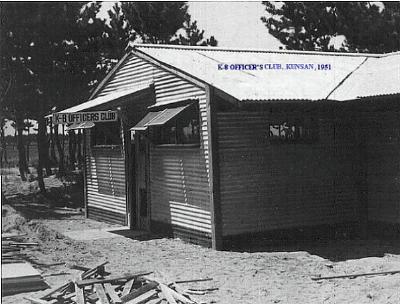 K-8 Officer Club (1951) K-8 Officer Club (1951)
(Courtesy Al Gould)
Click on photo to enlarge
For inputs or comments, contact Kalani O'Sullivan.NOTICE/DISCLAIMER: The content of this page is unofficial and the views and opinions expressed do not necessarily reflect those of anyone associated with this page or any of those linked from this site. All opinions are those of the writer and are intended for entertainment purposes only. Links to other web pages are provided for convenience and do not, in any way, constitute an endorsement of the linked pages or any commercial or private issues or products presented there.
|

